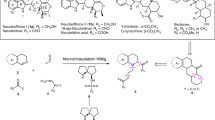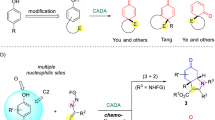Abstract
Prenylation is a ubiquitous process common to almost all living organisms, and a key transformation in organic synthesis. Dearomative prenylation reactions of tryptophan derivatives lead to various prenylated indoline alkaloids with diverse biological activities. However, enantioselective dearomative prenylations without a pre-installed stereogenic centre in the substrate have not been reported. Here, we show that a small molecule-based catalytic system derived from a commercially available palladium precursor and a chiral phosphoramidite ligand (allylphos) can catalyse the enantioselective dearomative prenylation of indole derivatives, which tolerates a much broader substrate scope than those of known enzymatic dearomative prenylation processes. Enantioselective dearomative geranylation and farnesylation reactions also proceed smoothly under the standard conditions. The concise total or formal syntheses of a series of natural products can be realized using this catalytic system. The mechanistic investigations provide deep insights for the further design of chiral ligands and catalysts for asymmetric reactions.
This is a preview of subscription content, access via your institution
Access options
Access Nature and 54 other Nature Portfolio journals
Get Nature+, our best-value online-access subscription
$29.99 / 30 days
cancel any time
Subscribe to this journal
Receive 12 digital issues and online access to articles
$119.00 per year
only $9.92 per issue
Buy this article
- Purchase on Springer Link
- Instant access to full article PDF
Prices may be subject to local taxes which are calculated during checkout





Similar content being viewed by others
References
Sacchettini, J. C. & Poulter, C. D. Creating isoprenoid diversity. Science 277, 1788–1789 (1997).
Walsh, C. T., Garneau-Tsodikova, S. & Gatto, G. J. Jr. Protein posttranslational modifications: the chemistry of proteome diversifications. Angew. Chem. Int. Ed. 44, 7342–7372 (2005).
Chang, W.-C., Song, H., Liu, H.-W. & Liu, P. Current development in isoprenoid precursor biosynthesis and regulation. Curr. Opin. Chem. Biol. 17, 571–579 (2013).
Zhang, H., Boghigian, B. A., Armando, J. & Pfeifer, B. A. Methods and options for the heterologous production of complex natural products. Nat. Prod. Rep. 28, 125–151 (2011).
Oldfield, E. & Lin, F.-Y. Terpene biosynthesis: modularity rules. Angew. Chem. Int. Ed. 51, 1124–1137 (2012).
Williams, R. M., Stocking, E. M. & Sanz-Cervera, J. F. Biosynthesis of prenylated alkaloids derived from tryptophan. Top. Curr. Chem. 209, 97–173 (2000).
Li, S.-M. Prenylated indole derivatives from fungi: structure diversity, biological activities, biosynthesis and chemoenzymatic synthesis. Nat. Prod. Rep. 27, 57–78 (2010).
Lindel, T., Marsch, N. & Adla, S. K. Indole prenylation in alkaloid synthesis. Top. Curr. Chem. 309, 67–129 (2011).
Carlé, J. S. & Christophersen, C. Bromo-substituted physostigmine alkaloids from a marine Bryozoa Flusta foliacea. J. Am. Chem. Soc. 101, 4012–4013 (1979).
Holst, P. B., Anthoni, U., Christophersen, C. & Nielsen, P. H. Marine alkaloids, 15. Two alkaloids, flustramine E and debromoflustramine B, from the marine Bryozoan Flustra foliacea. J. Nat. Prod. 57, 997–1000 (1994).
Wang, H.-J., Gloer, J. B., Wicklow, D. T. & Dowd, P. F. Mollenines A and B: new dioxomorpholines from the ascostromata of Eupenicillium molle. J. Nat. Prod. 61, 804–807 (1998).
Spande, T. F. et al. Pseudophrynamine A: an unusual prenyl pyrrolo[2,3-b]indole ester from an Australian frog, Pseudophryne coriacea (Myobatrachidae). J. Org. Chem. 53, 1222–1226 (1988).
Badio, B., Garraffo, H. M., Padgett, W. L., Greig, N. H. & Daly, J. W. Pseudophrynaminol: a potent noncompetitive blocker of nicotinic receptor-channels. Biochem. Pharmacol. 53, 671–676 (1997).
Skiredj, A., Beniddir, M. A., Evanno, L. & Poupon, E. Mimicking the main events of the biosynthesis of drimentines: synthesis of Δ8’-isodrimentine A and related compounds. Eur. J. Org. Chem. 2016, 2954–2958 (2016).
Tanner, M. E. Mechanistic studies on the indole prenyltransferases. Nat. Prod. Rep. 32, 88–101 (2015).
Austin, J. F., Kim, S.-G., Sinz, C. J., Xiao, W.-J. & MacMillan, D. W. C. Enantioselective organocatalytic construction of pyrroloindolines by a cascade addition–cyclization strategy: synthesis of (−)-flustramine B. Proc. Natl Acad. Sci. USA 101, 5482–5487 (2004).
Trost, B. M., Malhotra, S. & Chan, W. H. Exercising regiocontrol in palladium-catalyzed asymmetric prenylations and geranylation: unifying strategy toward flustramines A and B. J. Am. Chem. Soc. 133, 7328–7331 (2011).
Pape, A. R., Kaliappan, K. P. & Kündig, E. P. Transition-metal-mediated dearomatization reactions. Chem. Rev. 100, 2917–2940 (2000).
Davies, H. M. L. & Hedley, S. J. Intermolecular reactions of electron-rich heterocycles with copper and rhodium carbenoids. Chem. Soc. Rev. 36, 1109–1119 (2007).
Roche, S. P. & Porco, J. A. Jr. Dearomatization strategies in the synthesis of complex natural products. Angew. Chem. Int. Ed. 50, 4068–4093 (2011).
Zhuo, C.-X., Zhang, W. & You, S.-L. Catalytic asymmetric dearomatization reactions. Angew. Chem. Int. Ed. 51, 12662–12686 (2012).
Zhuo, C.-X., Zheng, C. & You, S.-L. Transition-metal-catalyzed asymmetric allylic dearomatization reactions. Acc. Chem. Res. 47, 2558–2573 (2014).
Repka, L. M., Ni, J. & Reisman, S. E. Enantioselective synthesis of pyrroloindolines by a formal [3+2] cycloaddition reaction. J. Am. Chem. Soc. 132, 14418–14420 (2010).
Jones, S. B., Simmons, B., Mastracchio, A. & MacMillan, D. W. C. Collective synthesis of natural products by means of organocascade catalysis. Nature 475, 183–188 (2011).
Spangler, J. E. & Davies, H. M. L. Catalytic asymmetric synthesis of pyrroloindolines via a rhodium(II)-catalyzed annulation of indoles. J. Am. Chem. Soc. 135, 6802–6805 (2013).
Xiong, H., Xu, H., Liao, S., Xie, Z. & Tang, Y. Copper-catalyzed highly enantioselective cyclopentannulation of indoles with donor−acceptor cyclopropanes. J. Am. Chem. Soc. 135, 7851–7854 (2013).
Nelson, H. M., Reisberg, S. H., Shunatona, H. P., Patel, J. S. & Toste, F. D. Chiral anion phase transfer of aryldiazonium cations: an enantioselective synthesis of C3-diazenated pyrroloindolines. Angew. Chem. Int. Ed. 53, 5600–5603 (2014).
Romano, C., Jia, M., Monari, M., Manoni, E. & Bandini, M. Metal-free enantioselective electrophilic activation of allenamides: stereoselective dearomatization of indoles. Angew. Chem. Int. Ed. 53, 13854–13857 (2014).
Zhao, X. et al. Asymmetric dearomatization of indoles through a Michael/Friedel–Crafts-type cascade to construct polycyclic spiroindolines. Angew. Chem. Int. Ed. 54, 4032–4035 (2015).
Jamison, C. R., Badillo, J. J., Lipshultz, J. M., Comito, R. J. & MacMillan, D. W. C. Catalyst-controlled oligomerization for the collective synthesis of polypyrroloindoline natural products. Nat. Chem. 9, 1165–1169 (2017).
Bera, S., Daniliuc, C. G. & Studer, A. Oxidative N-heterocyclic carbene catalyzed dearomatization of indoles to spirocyclic indolenines with a quaternary carbon stereocenter. Angew. Chem. Int. Ed. 56, 7402–7406 (2017).
Trost, B. M. & Crawley, M. L. Asymmetric transition-metal-catalyzed allylic alkylations: applications in total synthesis. Chem. Rev. 103, 2921–2944 (2003).
Lu, Z. & Ma, S. Metal-catalyzed enantioselective allylation in asymmetric synthesis. Angew. Chem. Int. Ed. 47, 258–297 (2008).
Trost, B. M. & Quancard, J. Palladium-catalyzed enantioselective C-3 allylation of 3-substituted-1H-indoles using trialkylboranes. J. Am. Chem. Soc. 128, 6314–6315 (2006).
Liu, Y. & Du, H. Pd-catalyzed asymmetric allylic alkylations of 3-substituted indoles using chiral P/olefin ligands. Org. Lett. 15, 740–743 (2013).
Kaiser, T. M. & Yang, J. Catalytic enantioconvergent decarboxylative allylic alkylation of allyl indolenin-3-carboxylates. Eur. J. Org. Chem. 2013, 3983–3987 (2013).
Ruchti, J. & Carreira, E. M. Ir-catalyzed reverse prenylation of 3-substituted indoles: total synthesis of (+)-aszonalenin and (−)-brevicompanine B. J. Am. Chem. Soc. 136, 16756–16759 (2014).
Zhang, X., Han, L. & You, S.-L. Ir-catalyzed intermolecular asymmetric allylic dearomatization reaction of indoles. Chem. Sci. 5, 1059–1063 (2014).
Trost, B. M. Designing a receptor for molecular recognition in a catalytic synthetic reaction: allylic alkylation. Acc. Chem. Res. 29, 355–364 (1996).
Trost, B. M., Machacek, M. R. & Aponick, A. Predicting the stereochemistry of diphenylphosphino benzoic acid (DPPBA)-based palladium-catalyzed asymmetric allylic alkylation reactions: a working model. Acc. Chem. Res. 39, 747–760 (2006).
Helmchen, G. & Pfaltz, A. Phosphinooxazolines—a new class of versatile, modular P,N-ligands for asymmetric catalysis. Acc. Chem. Res. 33, 336–345 (2000).
Noyori, R. & Takaya, H. BINAP: an efficient chiral element for asymmetric catalysis. Acc. Chem. Res. 23, 345–350 (1990).
Wang, M.-Z. et al. Total synthesis and absolute configuration reassignment of mollenines A and B. Org. Chem. Front. 5, 954–957 (2018).
Wollinsky, B., Ludwig, L., Xie, X. & Li, S.-M. Breaking the regioselectivity of indole prenyltransferases: identification of regular C3-prenylated hexahydropyrrolo[2,3-b]indoles as side products of the regular C2-prenyltransferase FtmPT1. Org. Biomol. Chem. 10, 9262–9270 (2012).
Alqahtani, N. et al. Synergism between genome sequencing, tandem mass spectrometry and bio-inspired synthesis reveals insights into nocardioazine B biogenesis. Org. Biomol. Chem. 13, 7177–7192 (2015).
Caballero, E., Avendaño, C. & Menéndez, J. C. Brief total synthesis of the cell cycle inhibitor tryprostatin B and related preparation of its alanine analogue. J. Org. Chem. 68, 6944–6951 (2003).
Defieber, C., Grützmacher, H. & Carreira, E. M. Chiral olefins as steering ligands in asymmetric catalysis. Angew. Chem. Int. Ed. 47, 4482–4502 (2008).
Feng, C.-G., Xu, M.-H. & Lin, G.-Q. Development of bicyclo[3.3.0]octadiene- or dicyclopentadiene-based chiral diene ligands for transition-metal-catalyzed reactions. Synlett 2011, 1345–1356 (2011).
Hegedus, L. S., Åkermark, B., Olsen, D. J., Anderson, O. P. & Zetterberg, K. π-Allyl)palladium complex ion pairs containing two different, mobile π-allyl groups: NMR and X-ray crystallographic studies. J. Am. Chem. Soc. 104, 697–704 (1982).
De Munno, G. et al. Crystal structure of [Pd(η3-2-propenyl)(dps)] [Pd(η3-2-propenyl)Cl2]. NMR evidence of binuclear η3-ally1 palladium(II) species with bridging dps. Inorg. Chim. Acta 208, 67–75 (1993).
Acknowledgements
We thank the National Key Research and Development Program of China (2016YFA0202900), National Basic Research Program of China (973 Program 2015CB856600), National Natural Science Foundation of China (21332009 and 21572252), Strategic Priority Research Program (XDB20000000) and Key Research Program of Frontier Sciences (QYZDYSSWSLH012) of the Chinese Academy of Sciences, and the Science and Technology Commission of Shanghai Municipality (16XD1404300) for generous financial support, and X. Leng and J. Sun (SIOC) for X-ray crystallographic analysis.
Author information
Authors and Affiliations
Contributions
H.-F.T. and X.Z. were involved in the discovery, design and development of the enantioselective dearomative prenylation of indole derivatives. X.Z. synthesized allylphos. H.-F.T. performed the total syntheses of the natural products. H.-F.T. and C.Z. performed the mechanistic studies. M.Z. was involved in the synthesis of substrates. S.-L.Y. conceived and supervised the project. H.-F.T., C.Z. and S.-L.Y. wrote the manuscript with revisions suggested by all authors.
Corresponding author
Ethics declarations
Competing interests
The authors declare no competing interests.
Additional information
Publisher’s note: Springer Nature remains neutral with regard to jurisdictional claims in published maps and institutional affiliations.
Supplementary information
Supplementary Information
Supplementary Methods, Supplementary Figures 1–3, Supplementary Tables 1–17, Supplementary References
Crystallographic data
CIF for compound C1; CCDC reference: 1822391
Crystallographic data
CIF for compound C2; CCDC reference: 1822392
Crystallographic data
CIF for compound 22; CCDC reference: 1822393
Crystallographic data
CIF for compound (R)-L1; CCDC reference: 1822394
Rights and permissions
About this article
Cite this article
Tu, HF., Zhang, X., Zheng, C. et al. Enantioselective dearomative prenylation of indole derivatives. Nat Catal 1, 601–608 (2018). https://doi.org/10.1038/s41929-018-0111-8
Received:
Accepted:
Published:
Issue Date:
DOI: https://doi.org/10.1038/s41929-018-0111-8
This article is cited by
-
Photoredox-catalyzed diastereoselective dearomative prenylation and reverse-prenylation of electron-deficient indole derivatives
Nature Communications (2023)
-
Enantioselective synthesis of γ-butenolides through Pd-catalysed C5-selective allylation of siloxyfurans
Nature Synthesis (2022)
-
Nickel-catalysed asymmetric heteroarylative cyclotelomerization of isoprene
Nature Catalysis (2022)
-
Cascade asymmetric dearomative cyclization reactions via transition-metal-catalysis
Nature Synthesis (2022)
-
Electrooxidation enables highly regioselective dearomative annulation of indole and benzofuran derivatives
Nature Communications (2020)



